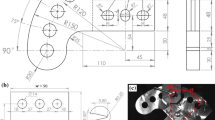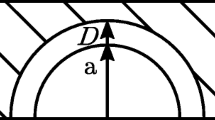Abstract
Microcracks which develop at the surface of Al 2048 subjected to fully reversed fatigue loading are found to be partially open at zero load. The magnitude of such residual crack openings measured at the test specimen surface is determined as a function of the crack length and the relative humidity in which the specimens were fatigued. For a fixed crack length the residual crack openings are found to be largest if the relative humidity is low or if the crack path is particularly irregular. The present interpretation of the phenomenon is that the residual crack openings are indirectly related to the crack closure load associated with the microcracks.
Similar content being viewed by others
References
W. G. Clark:Met. Eng. Quart., 1974, vol. 14, no. 3, pp. 16–22.
S. Pearson:Eng. Fract. Mech., 1975, vol. 7, pp. 235–47.
C. Q. Bowles and J. Schijve:Int. J. Fract., 1973, vol. 9, pp. 171–79.
J. C. Grosskreutz and G. G. Shaw:Fracture, 1969, pp. 620.
M. A. Hempe:Fracture, pp. 376, Technology Press, MIT, 1969.
W. Elber: STP 486, p. 230, American Society for Testing and Materials, Philadelphia, 1971.
M. Katcher and M. Kaplan: STP 559, p. 208, American Society for Testing and Materials, 1974.
P. E. Irving, J. L. Robinson, and C. J. Beevers:Int. J. Fract., 1973, vol. 9, pp. 105–08.
T. T. Shih and R. P. Wei:Eng. Fract. Mech., 1974, vol. 6, pp. 19–32.
T. C. Lindley and C. E. Richards:Mater. Sci. Eng., 1974, vol. 14, pp. 281–93.
N. J. I. Adams:Eng. Fract. Mech., 1972, vol. 4, pp. 543–54.
O. Buck, C. L. Ho, H. L. Marcus, and R. B. Thompson: STP 513, p. 280, American Society for Testing and Materials, 1972.
O. Buck, C. L. Ho, and H. L. Marcus:Eng. Fract. Mech., 1973, no. 5, pp. 23–34.
J. D. Frandsen, R. V. Inman, and O. Buck:Int. J. Fract. Mech., 1975, vol. 11, no. 2, pp. 345–47.
O. Buck, J. D. Frandsen, C. L. Ho, and H. L. Marcus: inMicrostructure and Design of Alloys, vol. 1, pp. 462–66, The Institute of Metals and Iron and Steel Institute, 1973.
O. Buck, J. D. Frandsen, and H. L. Marcus:Eng. Fract. Mech., 1975, vol. 7, pp. 167–71.
P. E. Irving, J. L. Robinson, and C. J. Beevers:Eng. Fract. Mech., 1975, vol. 7, pp. 619–30.
J. C. Newman:Proceedings of the 8th National Symposium on Fracture Mechanics, ASTM STP (in press).
W. L. Morris, O. Buck, and H. L. Marcus:Met. Trans. A, 1976, vol. 7A, pp. 1161–65.
W. L. Morris and O. Buck: Unpublished work, Science Center, Rockwell International, Thousand Oaks, Calif. 91360.
H. L. Marcus, W. L. Morris, O. Buck, and J. D. Frandsen:Prospects of Fracture Mechanics, pp. 179–91, Noordhoff International Publishing, The Netherlands, 1974.
Author information
Authors and Affiliations
Rights and permissions
About this article
Cite this article
Morris, W.L. The early stage of fatigue crack propagation in al 2048. Metall Trans A 8, 589–596 (1977). https://doi.org/10.1007/BF02676980
Received:
Issue Date:
DOI: https://doi.org/10.1007/BF02676980




